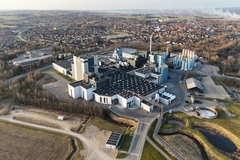
- Industry news
Industry news
- Category news
Category news
- Reports
- Key trends
- Multimedia
- Journal
- Events
- Suppliers
- Home
- Industry news
Industry news
- Category news
Category news
- Reports
- Key trends
- Multimedia
- Events
- Suppliers
Innovation, Efficiency Are Keys to Tyson’s Continued Success

Tyson’s customer support efforts include a product development process called “Discovery,” which is designed to drive innovation in products and services by understanding the customer's customer.

30/11/06 Innovation and cost efficiency are strategic to the future success of Tyson Foods, Inc. and, according to two key Tyson executives, the company is making strides in both areas.
Wendy Davidson, senior vice president of Food Service National Accounts, and Jim Lochner, senior group vice president of Fresh Meats and Margin Optimization, both spoke Wednesday at the JP Morgan Consumer and Retail Holiday Conference in New York City.
Davidson told analysts and investors how the company is fostering product innovation and customer satisfaction. “Because of our business presence in both foodservice and retail, we’re uniquely positioned to understand the consumer 24-7,” said Davidson. “We know where they eat and what they crave, 24 hours a day, seven days a week. Our ability to capitalize on this insight is a tremendous benefit as we seek to drive sales growth.”
Tyson’s customer support efforts include a product development process called “Discovery,” which is designed to drive innovation in products and services by understanding the customer's customer. “Our approach to new product innovation in foodservice is to partner with our customers from innovation to execution,” Davidson said. “Understanding the consumer and our customer’s business needs allows us to work jointly on new products to drive their business, which in turns drives ours.”
Davidson said Tyson’s product innovation efforts will soon get a major boost from the company’s new Discovery Center, named after the company's customer innovation process. This new R&D facility is scheduled to open in January 2007.
“We will be the only company in the industry with consumer research, 19 development kitchens, a federally-inspected pilot plant handling all three proteins and more than 100 certified culinologists on staff to bring ideas to market in a matter of days,” she said.
Another Tyson customer resource is called “Meat Max,” a category management process, which goes beyond simple stock keeping unit (SKU) management to include trade area and consumer analysis to market the product at the right time and place. Tyson is the first to offer this complete category management tool to the foodservice marketplace with initial results impacting customer growth by over 10%.
Davidson also noted that while Tyson is known for center-of-the-plate chicken, beef and pork, the company’s products span the entire menu, from appetizers, bacon, chicken sandwiches and pizza ingredients to desserts, deli meats and soups. For example, she pointed out the company’s market share of 40% in the production of pepperoni, an estimated 25% share of the chicken appetizer market, a 10% share of the bacon market and a greater than 30% share of the pizza crust and toppings business.
Lochner highlighted the ways the company is managing costs and revenues in its commodity and value-added businesses.
“The focus in our commodity businesses is on execution and innovation,” he said. “This means execution in manufacturing to improve yields and labor costs, and innovation in pricing and risk management to maximize revenues.”
For example, yield maximization is critical when you consider the number of livestock the company processes, according to Lochner. “In beef a mere 0.5% yield gain or loss is the equivalent of more than $60 million in revenue when you consider the number of cattle we handle annually.”
Lochner also emphasized the importance of moving more of the company’s products up the value chain, through additional processing and/or cooking. More than 70% of Tyson's poultry products are considered value-added and a growing percentage of the company's beef and pork products are also in value-added categories.
“This gives us the opportunity to improve our return on sales as it decreases our percentage of sales dollars in raw material costs,” said Lochner. For example, it gives the company an advantage over commodity poultry producers, since input costs such as grain represent a lower percent of sales.
“We’re driven to be the low cost, high revenue protein company in all three species and to use our value added mix and growth of that mix to our competitive advantage,” he said.










